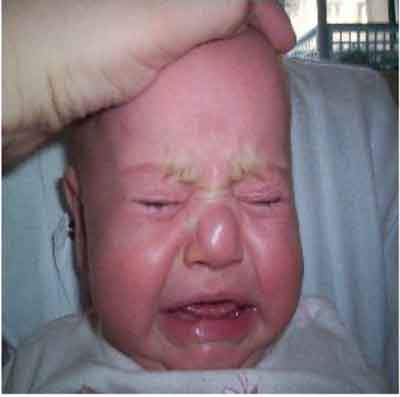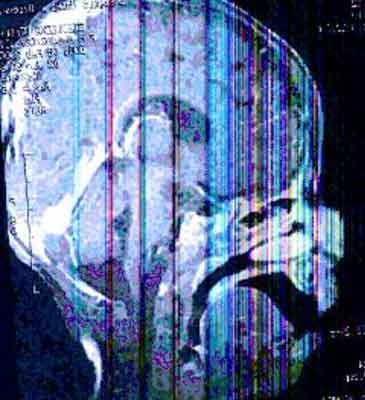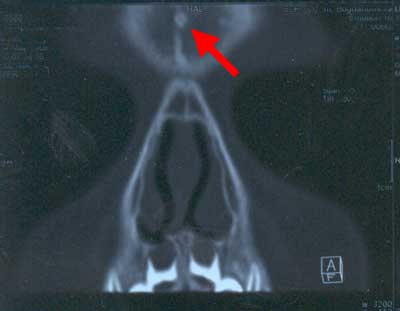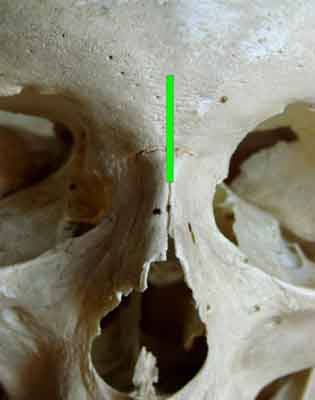© Borgis - New Medicine 3/2008, s. 52-54
*Lechosław P. Chmielik, Monsoor Sharifi
RARE TUMOURS OF THE DORSUM OF THE NOSE
Department of Paediatric Otorhinolaryngology, Medical University of Warsaw, Poland
Head of Department: Prof. Mieczysław Chmielik, MD, PhD
Summary
Introduction: Tumours of the dorsum of the nose are rarely found. The most common cysts of the dorsum are fibromas, chondromas and angiomas. Other tumours of the dorsum are even rarer. Any change within a child´s dorsum requires special attention.
It is important to eliminate the possibility of encephalomeningocele, as well as any connection with the anterior fossa of the skull.
Aim: To analyse case histories taken from children treated during 2005-2007 in the Paediatric ENT Clinic in Warsaw
Material and method: The case histories analysed are those of children treated in the last 3 years in the Paediatric ENT Clinic in Warsaw. The first case is that of an eight-month-old girl referred for a tumour in the dorsum of the nose. Histopathological examination after surgical treatment revealed a ganglioma. The second case concerns a nine-year-old boy with a cyst in the dorsum of the nose. During surgery, an atypical location of the cyst was found between the nasal bones and
the skin, terminating in the frontal bone.
Results: The first case is that of an eight-month-old girl referred for a tumour in the dorsum of the nose. MRI showed a tumour with no contact with the central nervous system. The child was qualified for surgery, which was carried out. The second case concerns a nine-year-old boy with a cyst in the dorsum of the nose. During surgery, an atypical location of the cyst was found, between the nasal bones and the skin, terminating in the frontal bone.
Conclusions: The most frequent causes of swellings in the dorsum of the nose are developmental defects. In unusually thin locations this is ganglioma, and a dermoid cyst can also have an atypical location.
INTRODUCTION
Tumours of the dorsum of the nose are rare. The most common cysts of the dorsum are fibromas, chondromas, and angiomas. Cysts originate mainly in the skin of the dorsum or apex of the nose, spreading in the connective tissue between the cartilage and bones of the nose. Sometimes the cyst causes some destruction of the bones. Other tumours of the dorsum are even rarer. Change within a child´s dorsum requires special attention. It is important to eliminate the possibility of encephalomeningocele, as well as any connection with the anterior fossa of the skull.
AIM
To analyse case histories taken from children treated during 2005-2007 in the Paediatric ENT Clinic in Warsaw.
MATERIAL AND METHOD
The case histories analysed are taken from children treated during 2005-2007 in the Paediatric ENT Clinic in Warsaw. The material under examination included nine tumours and one developmental anomaly. In the material collected two cases have been found showing atypical symptoms.
RESULTS
The first case is that of an eight-month-old girl referred for a tumour in the dorsum of the nose (fig. 1). MRI showed a tumour with no contact with the central nervous system (fig. 2). The child was qualified for surgery, which was carried out. A semicircular cut was performed on the skin of the lateral wall of the nose. During the operation a hard tumour connected with the skin was discovered and removed. Histopathological examination in Department of Paediatric Pathologic Anatomy Medical University of Warsaw after surgical treatment revealed a ganglioma. Ganglioma congenitum (splitting off brain tissue) in the area of the nose very seldom occurs in children. In the post-operative period a slight local necrosis developed in the skin, which later healed.

Fig. 1. A tumour in the dorsum of the nose.

Fig. 2. MRI of the tumour in the dorsum of the nose.
The second case concerns a nine-year-old boy, with a cyst in the dorsum of the nose (fig. 3). During surgery, an atypical location of the cyst was found, between the nasal bones and the skin, terminating in the frontal bone (fig. 4). Typically, a cyst of the nasal dorsum spreads under the bones and reaches the base anterior fossa of the skull. Histopathology in Department of Paediatric Pathologic Anatomy Medical University of Warsaw revealed it to be a dermoid cyst.

Fig. 3. A cyst in the dorsum of the nose.

Fig. 4. CT of the cyst in the dorsum of the nose terminating in the frontal.
DISCUSSION
Most authors agree that the most frequent tumour of the nasal dorsum is a cyst (1, 2, 8, 9, 10). Histopathologically it is most commonly a dermoid cyst. Dermoid cysts may occur in various locations. Within the area of the head and neck they can develop internally or externally (5). Most often, the cyst originates in the skin apex or dorsum of the nose. Typically, the cyst spreads under the bones and reaches the base anterior fossa of the skull (fig. 5) (9). In the described case an atypical location of the cyst was found between the nasal bones and the skin, terminating in the frontal bone (fig. 6).

Fig. 5. Typically, the cyst spreads.

Fig. 6. Atypical location of the cyst was found between the nasal bones and the skin.
Other tumours of the nasal dorsum are quite rare. Ganglioma congenitum is mostly situated in the cerebral cranium (3, 4, 6, 7); other locations are rare.
CONCLUSIONS
The most frequent causes of swellings in the dorsum of the nose are developmental defects. In unusually thin locations this can be ganglioma congenitum. Dermoid cysts can also have an atypical location.
Piśmiennictwo
1. Bradley PJ.: The complex nasal dermoid. Head & Neck Surgery. Jul 2006; 5 (6): 469 473. 2. Cambiaghi S, Micheli S.: Nasal Dermoid Sinus Cyst. Pediatric Dermatology Nov 2007; 24 (6): 646-650. 3. Kumar R, Singh V.: Intramedullary mass lesion of the spinal cord in children of a de veloping milieu. Pediatr Neurosurg. 2004; Jan-Feb; 40 (1): 16-22. 4. Manning HL, Leiter JC.: Respiratory control and respiratory sensation in a patient with a ganglioma within the dorsocaudal brain stem. Am J Respir Ceit Care Med. 200 Jun; 161 (6): 2100-6. 5. Meitner ER, Gajdos E.: Intracranial dermoid cyst (clinico-pathologic description of a case) Psychiatr Neurol Med. Psychol (Leipz)1984; Apr; 36 (4): 223-8. German. 6. Price DB, Miller LJ.: Congenital ganglioma: report of a case with an unusual imaging appearance. Pediatr Radiol. 1997; Sep; 27 (9): 748-9. 7. Sandalcioglu IE, Gasser T, Asgari S, et all.: Functional outcome after surgical treatment of intramedullary spinal cord tumors: experience with 78 patients. Spinal Cord. 2005; Jan 43 (1): 34-41. 8. Skolnicki EM, Campbell JM, Meyers RM.: Dermoid cyst of the nose. Laryngoskope 1971; 81, 1632. 9. Vandrell MA, Carrasco Torrents R, Parn Ferrandis FJ.: Nasal congenital cysts and fistulas: clinical and surgical aspects. Cir Pediatr. 1998; 11 (3): 90-2. 10. Zakrzewski K; Respondek-Liberska M.: Brain tumors in newborns and infants; Arch. Perinat. Med. 2003; 9 (2): 47-49. 11. Chmielik M.: Results of surgical treatment of congenital cysts of the nasal dorsum in children. Rhinology 1979, XVII, 275-279.





